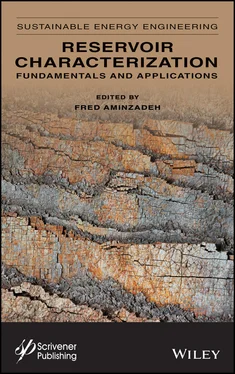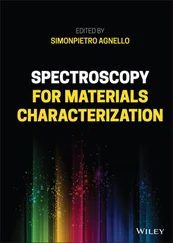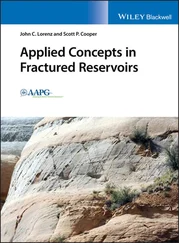27 17 Distinguishing Between Brine-Saturated and Gas-Saturated Shaly Formations with a Monte-Carlo Simulation of Seismic Velocities 17.1 Introduction 17.2 Random Models for Seismic Velocities 17.3 Variability of Seismic Velocities Predicted by Random Models 17.4 The Separability of ( Vp , Vs ) Clusters for Gas- and Brine-Saturated Formations 17.5 Reliability Analysis of Identifying Gas-Filled Formations 17.6 Conclusions References
28 18 Shale Mechanical Properties Influence Factors Overview and Experimental Investigation on Water Content Effects 18.1 Introduction 18.2 Influence Factors 18.3 Experimental Investigation of Water Saturation Effects on Shale’s Mechanical Properties 18.4 Conclusions Acknowledgements References
29 Part 6: Enhance Oil Recovery
30 19 A Numerical Investigation of Enhanced Oil Recovery Using Hydrophilic Nanofuids 19.1 Introduction 19.2 Simulation Framework 19.3 Coupling of Mathematical Models 19.4 Verification Cases 19.5 Results 19.6 Discussions 19.7 Conclusions and Future Work References
31 20 3D Seismic-Assisted CO 2-EOR Flow Simulation for the Tensleep Formation at Teapot Dome, USA 20.1 Presentation Sequence 20.2 Introduction 20.3 Geological Background 20.4 Discrete Fracture Network (DFN) 20.5 Petrophysical Modeling 20.6 PVT Analysis 20.7 Streamline Analysis 20.8 CO 2-EOR 20.9 Conclusions Acknowledgement References
32 Part 7: New Advances in Reservoir Characterization-Machine Learning Applications
33 21 Application of Machine Learning in Reservoir Characterization 21.1 Brief Introduction to Reservoir Characterization 21.2 Artificial Intelligence and Machine (Deep) Learning Review 21.3 Artificial Intelligence and Machine (Deep) Learning Applications to Reservoir Characterization 21.4 Machine (Deep) Learning and Enhanced Oil Recovery (EOR) 21.5 Conclusion Acknowledgement References
34 Index
35 End User License Agreement
1 Chapter 1 Figure 1.1 Different components of reservoir characterization, from Fornel and E... Figure 1.2 Wide range of physical scale for different data types associated with... Figure 1.3 SURE Challenge: Having to deal with the wide ranges of Scale, Uncerta... Figure 1.4 Areal coverage of well data is complemented by the larger areal sampl... Figure 1.5 Vertical and spatial resolution of various geophysical, well logs and... Figure 1.6 Time-lapse seismic response changes caused by different positions of ... Figure 1.7 Use of conventional seismic, well log data and MEQ data to create a 3... Figure 1.8 The entire process of reservoir model updating through 4D seismic mod... Figure 1.9 Reservoir modeling process workflow. The process takes control of the... Figure 1.10 Integrated reservoir modeling, fluid simulation update and reiterati...
2 Chapter 2 Figure 2.1 Common methods for estimating the shear wave velocity. Figure 2.2 The placement of the test device is shown in schemati. Figure 2.3 Schematic, placement of sample with transducer and the top cap. Figure 2.4 (a) The core flooding system, (b) Image of the holder connected to th... Figure 2.5 Compressional and shear wave velocity vs different effective pressure... Figure 2.6 P-wave velocity (experimental and estimated) at different effective p... Figure 2.7 S-wave velocity (experimental and estimated) at different effective p... Figure 2.8 Cross plot of estimated P-wave velocities vs. laboratory measurements... Figure 2.9 Cross plot of the estimated S-wave velocities vs. laboratory measurem... Figure 2.10 Plot of experimental shear wave velocity against compressional wave ... Figure 2.11 Plot of estimated shear wave velocity against compressional wave vel... Figure 2.12 Rate of variability of experimental/estimated velocities with increa... Figure 2.13 Plot of Laboratory vs. estimated Bulk modulus (K) of rock sample. Figure 2.14 Plot of laboratory vs. estimated shear modulus. Figure 2.15 Plot of laboratory vs. estimated Young’s modulus.
3 Chapter 3 Figure 3.1 Divergence values for records in training and test set. The horizonta... Figure 3.2 Expected versus posterior false discovery rate for two sizes of the t... Figure 3.3 Histograms of area under posterior ROC Curve (AUC) for three anomaly ... Figure 3.4 AUC histograms and quantile regions calculated from 1000 pairs of tra... Figure 3.5 Median of posterior AUC for three AD classifiers as a function of the... Figure 3.6 Quantile width of AUC distribution calculated on anomaly detection re... Figure 3.7 Sparsity values on the records of the training and test sets. Horizon... Figure 3.8 Anomaly detection. Histograms of posterior true discovery rate (TDR) ... Figure 3.9 Histograms of anomalyIndicator for three types of classifiers. (a)-ad...
4 Chapter 4 Figure 4.1 Type of Kerogen present in source rocks. Figure 4.2 It shows kerogen conversion and maturity (Tmax). Figure 4.3 Bulk compositions of oils and bitumen studied. Figure 4.4 GC-Fingerprint of a carbonate-derived oil. Figure 4.5 GC-Fingerprint of a shale facies derived oil. Figure 4.6 GC- Fingerprint of Tertiary Oil No. 3 which is severely biodegraded. Figure 4.7 GC- Fingerprint of Cretaceous Oil No. 3 which is not biodegraded. Figure 4.8 Triterpane fingerprints of carbonate-derived oil. Figure 4.9 Triterpane fingerprint of shale-derived oil. Figure 4.10 Cross plot of dibenzothiophene/phenanthrene versus pristane/phaytane...
5 Chapter 5Figure 5.1a Prototype single-siren tool (assembled).Figure 5.1b Prototype single-siren tool (disassembled).Figure 5.2a Example MWD collar used for siren frequency and source placement opt...Figure 5.2b Drillpipe p/Dp to 12 Hz.Figure 5.2c Drillpipe p/Dp to 50 Hz.Figure 5.2d Drillpipe p/Dp to 100 Hz.Figure 5.3a Three step pulse recovery in noisy environment (pressure, vertical; ...Figure 5.3b Three step pulse recovery ( very noisy environment).Figure 5.4a Early 1980s “stable closed’ siren (left) and improved 1990s “stable-...Figure 5.4b Streamline traces for erosion analysis.Figure 5.4c Velocities for erosion and pressure analysis.Figure 5.5a Short “hydraulic” wind tunnel system.Figure 5.5b Very long “acoustic” wind tunnel.Figure 5.5c A pair of ganged or tandem mud sirens.Figure 5.5d Some sirens tested in wind tunnel.Figure 5.5e Evaluation of hub convergence effects on signal strength and torque.Figure 5.5f Flow straighteners (PVC tubing) for upstream and downstream use.Figure 5.5g Flow meter.Figure 5.5h Siren test section with differential transducers.Figure 5.5i Real-time data acquisition and control system.Figure 5.5j Torque, position and rpm counter.Figure 5.5k Short wind tunnel, “bird’s eye” view.Figure 5.5l Test shed window overlooking long wind tunnel.Figure 5.5m Piezoelectric transducer closest to siren for constructive interfere...Figure 5.5n Distant multiple transducer array setup.Figure 5.5o Fireworks for low frequency noise generation, when all else is unava...Figure 5.6a Siren Dp vs ω at with flow rate fixed.Figure 5.6b Low-frequency (10 Hz) long wind tunnel data.Figure 5.6c Low-frequency (10 Hz) signal recovery.Figure 5.6d High-frequency (45 Hz) long wind tunnel data.Figure 5.6e High-frequency (45 Hz) signal recovery.Figure 5.7a Method 4-3, A-002 (8 feet).Figure 5.7b Method 4-3, A-003 (12 feet).Figure 5.7c Method 4-3, A-004 (16 feet).Figure 5.7d Method 4-3, A-005 (20 feet).Figure 5.7e Method 4-3, B-002 (8 feet).Figure 5.7f Method 4-3, B-004 (16 feet).Figure 5.7g Method 4-3, A-002 (8 feet).Figure 5.7h Method 4-3, A-003 (12 feet).Figure 5.7i Method 4-3, A-004 (16 feet).Figure 5.7j Method 4-3, A-005 (20 feet).Figure 5.7k Method 4-3, B-003 (12 feet).Figure 5.7l Method 4-3, B-006 (24 feet).Figure 5.7m Method 4-3, A-002 (8 feet).Figure 5.7n Method 4-3, A-004 (16 feet).Figure 5.7o Method 4-3, A-006 (24 feet).Figure 5.7p Method 4-3, B-006 (24 feet).Figure 5.7q Method 4-3, B-008 (32 feet).Figure 5.8a Method 4-4, Run C-1.Figure 5.8b Method 4-4, Run C-2.Figure 5.8c Method 4-4, Run C-3.Figure 5.8d Method 4-4, Run C-4.Figure 5.8e Method 4-4, Run C-5.
Читать дальше








